Asafoetida Health Benefits, Medicinal Uses, Side Effects – Ayurveda
Asafoetida is an ancient Indian culinary ingredient, loaded with immense health benefits. Its powder with buttermilk is a very famous Indian home remedy for bloating. It is known as Hingu in Sanskrit and also in many other languages.
Botanical name: Ferula narthex / Ferula foetida / Ferula asafoetida
Family: Umbelliferae (Satapushpa Kula)
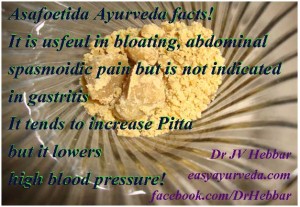
Table of Contents
Vernacular names, Sanskrit synonyms
Hindi name: Heeng, Hing
Kannada name: Hingu
Telugu name: Inguva
Bengali, Marathi name: Hing
Gujarati name: Badharani
Tamil name: perungayam
Malayalam name: perungayam, kayam
Farsi name: Angajah, Angoj
Arabbi name: Hilteel
Sanskrit Synonyms and meaning:
Hingu, Sahasravedhi – effective in thousands of ways
Jatuka – similar to Laksha herb, having exudate
Bahleeka, Ramatha – Available in places like Bahlika and Ramatha
Ugragandha – has offensive smell
Jantughna, Jantunasaka – It kills worms
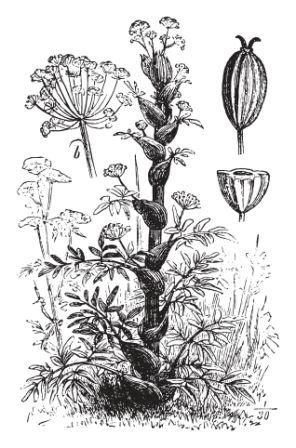
Classical categorization
Charaka samita:
Deepaneeya – herbs that improve digestion power
Svasahara – herbs that are useful in asthma and other respiratory disorders
Sanjnasthapana – herbs that are useful to restore consciousness
Katuskandha – pungent tasting group of herbs
Sushruta: Pippalyadi and Ushakadi
Vagbhata: Pippalyadi
Bh. P. Ni – Haritakyadi varga
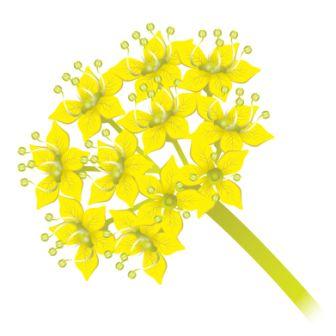
Distribution
Afghanistan, Baltistan, etc
Morphology
Perennial Herb
Root – Fusiform
Leaves – Pubescent when young, Cauline sheaths are large, from which inflorescence comes out
Inflorescence – Terminal compound umbel
Fruit – Having vitte, reddish – brown in color
Varieties
Different species used for Hingu along with ferula foetida
Ferula thomsoni
Ferula sumol
Ferula suaveolens
Ferula persica
Ferula alliaceae
Adulterants
Usually pebbles, mud, leaves and gum acacia are the things used as adulterants
Collection
Collection
The collection is done by laying bare the root stock to a depth of 4-5 cm of those plants which have not reached their flowering stage. Then it is cut off as a slice from the top of the root stock, from which at once a milky juice starts exuding, which is not collected. The root then is covered over by a domed structure called ‘Khora’ formed of twigs and covered with clay, leaving an opening towards the north, thus protecting the exposed root from the rays of the sun. After six weeks, a thick gummy, reddish substance appears in more or less irregular lumps upon the exposed surface of the root, which is scraped off with a piece of iron hoop or removed along with a slice of root and at once placed in a leather bed, the tanned skin of goat.
Medicinal qualities
Rasa (taste): Katu (pungent)
Guna (qualities): Laghu (light to digest), Snigdha (unctuous, oily), Teekshna (piercing, enters deep tissues)
Vipaka (taste conversion after digestion): Katu (pungent)
Veerya (potency): Ushna (hot)
Effect on Tridosha: Balances Kapha and Vata. Increases Pitta.
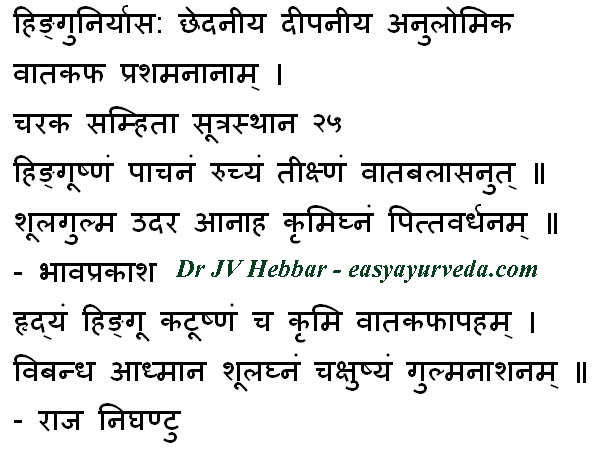
Asafoetida benefits
हिङ्गु वातकफानाह शूलघ्नं पित्त कोपनम्॥१५२॥
कटुपाकरसं रुच्यं दीपनं पाचनं लघु । – Astanga Hridaya Sutrasthana 6th chapter / 152
Hingu is
Chedaneeya – scrapes channels
Deepaneeya – carminative
Anulomana – restores normal movement of Vata, useful in bloating
Pachana – digestive
Teekshna (piercing, enters deep tissues)
Hrudya – good for heart, cardiac tonic. It is a very good natural blood thinning agent. It is also seen to be useful in high blood pressure.
Pittavardhana – increases Pitta.
Chakshushya – good for eyes, improves vision power
Useful in
Shula – abdominal colic pain
Gulma – Abdominal tumor, bloating
Udara – ascites
Anaha – bloating
Krumi – worm infestation
Vibandha – constipation
Adhmana – bloating, gaseous distension of abdomen
Gulma – Abdominal tumor, bloating
हिङ्गु शूलप्रशमनं विद्यात् पाचनरोचनम्||२९९||
vātaśleṣmavibandhaghnaṃ kaṭūṣṇaṃ dīpanaṃ laghu|
hiṅgu śūlapraśamanaṃ vidyāt pācanarocanam||299|| – Charaka Samhita Sutrasthana 27
The gum resin of Hingu – Asa foetida( Ferula narthex Boiss) reduces colic pain, is carminative and palatable.
Qualities as per Bhojana kutuhalam
According to Bhojana Kutuhalam as mentioned in the section of sambhara, hingu helps in treating vitiation of vata and kapha doshas, bloating of the abdomen, colicky pain and aggravates pitta dosha. It is pungent in its post metabolic effect, loosens the stools, is dry in nature, checks splenic disorders, flatulence and hernia.
How to Use Asafoetida for Bloating?
Part used, Dosage
Part used: Resin
Dosage: Asafoetida powder – 125 – 500 mg per day, or as directed by Ayurvedic an doctor.
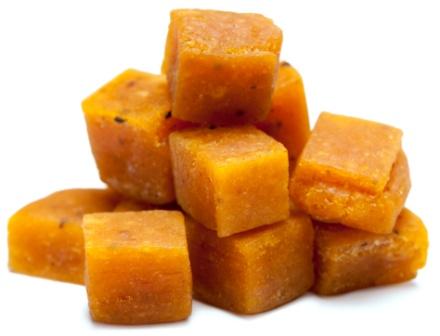
Asafoetida side effects
Overdosage may cause Pitta increase, burning sensation, worsening of gastritis.
It is not indicated in conditions with Pitta dominance, like gastritis.
It is best to avoid its use during menstrual periods.
It is best to avoid this in bleeding disorders. It has a blood thinning effect, hence it may delay clotting.
It is best to avoid this in children, pregnancy and lactation period.
People taking medicine for high blood pressure should take care while using Heeng, since it reduces blood pressure.
Interaction with medicines, supplements
Can this be used while taking Homeopathic medicine?
Yes. This product does not react with homeopathic medicine.
Can this medicine be continued while taking supplements like multivitamin tablets, Omega 3 fatty acids etc?
Yes. Generally, this product goes well with most dietary supplements. However, if you are taking more than one product per day, please consult your doctor for an opinion.
With western
medicines
Seek your
doctor’s advice if you are taking this product along with other western
(allopathic / modern) medicines. Some Ayurvedic herbs can interact with modern
medicine.
If both Ayurvedic and allopathic medicines are advised together, then it is
best to take Allopathic medicine first, wait for 30 minutes and then take the
Ayurvedic medicine.
Ayurvedic medicines
Famous Ayurvedic medicines prepared with Heeng:
Ashta Choornam – very famous carminative medicine.
Phalasarpis – useful in gynecologicaldisorders
Kankayan Vati – useful in bloating, piles etc.
Treatment for overdose
In case of poisoning caused due to hingu, tamarind which is dissolved in water is given. Sheetopachara i.e. food and drinks prepared from cold potency drugs are given. Even by administering ghee, the poisoning caused due to hingu will be cured. – Vaidya Sara Sangraha
Market available form
Why heeng -mixed with Maida or wheat flour and sold in the market?
Because, the original heeng might not be stable for long due to its semi solid consistency.
It is highly aromatic and judging how much to be added to dishes can be difficult. Hence, it is sold mixed with Maida or wheat flour.
Systemic Action (Sthanika Karma)
External – External application of Hingu paste has Analgesic, Antispasmodic, action. Helps to pacify vata dosha. Relieve abdominal distension, colic pain etc. Along with Castor oil it can be administered as Basti (Enema) . In conditions like impotency, it can be applied over penis. External application of Hingu paste is also indicated in respiratory disorders like cough and breathing difficulties.
Nervous System – Stimulant, Analgesic, Help to regain consciousness, Anti epileptic. Indicated in Hemiplegia, Facial palsy, Sciatica, Convulsions, etc.
Digestive System – Appetizer, increase digestive fire, Antispasmodic, indicated in loss of appetite, anorexia, constipation, Colic pain, phantom tumor, indigestion, helminthiasis.
Circulatory System – Good for Heart
Respiratory System –Helps to eliminate vitiated kapha dosha from the respiratory passage, Anti microbial. Indicated in chronic cough, Pulmonary edema, breathing disorders etc.
Excretory System – Induce urine production indicated in vatika mootrakrichra
Reproductive System – Indicated in impotency, in dysmenorrhea. Cleanses the uterus, can be used after delivery.
Skin – As it contains Sulphur, it is indicated in skin disorders. reduces itching
Satmikarana – Helps to regain body strength. Improve digestion and absorption.
Tapakrama – Indicated in fever (Vishama jvara, Sannipata jvara, Sita jvara). Relieve cold (Sita prasamana)











14 comments
rohini
plz send details for amla oil,
Dr J V Hebbar MD(Ayu)Author
Read it here – https://www.easyayurveda.com/2012/04/18/how-to-make-hair-oil-at-home-with-amla/
Serk
Sir, can Asafoetida be taken raw after meals as a digestive help. I read somewhere that Asafoetida should always be roasted before taking it. If so should the Asafoetida Powder be roasted plainly in a pan or does it need to be roasted in some kind of fat like Ghee? Thank you.
Dr J V Hebbar MD(Ayu)Author
Usually asafoetida is used after frying in ghee.
Dr.krishna
sir can you help me with the detailed phytochemical analysis report of Hingu?
Dr J V Hebbar MD(Ayu)Author
Please go here
http://iamj.in/posts/images/upload/1368_1374.pdf
http://www.alliedacademies.org/articles/study-of-the-phytochemical-analysis-andantimicrobial-activity-of-dodonaea-viscosa.pdf
Raghavendra
Hello Doctor,how to use hing for vata.Because hing alone is increasing vata because of its katu vipaka.Please reply
Dr J V Hebbar MD(Ayu)Author
By frying in ghee.
VARUN N RAO
Hello Doctor,
Why is Hingu prohibited food to yogis according to Hatha-Yoga pradipika?
Dr J V Hebbar MD(Ayu)Author
Probably due to its Pitta increasing effect.
Prasad Karkare
Doctor, why we get heeng mixed with maida in market? Why not pure heeng?
Dr J V Hebbar MD(Ayu)Author
Because, the original heeng might not be stable for long due to its semi solid consistency.
It is highly aromatic and judging how much to be added to dishes can be difficult. Hence, it is sold mixed with Maida or wheat flour.
Waheeda
Can use of hing cause restlessness or insomnia?
Dr J V Hebbar MD(Ayu)Author
Yes, it can aggravated Pitta Dosha and cause burning sensation. Avoid it or use it after frying in ghee.